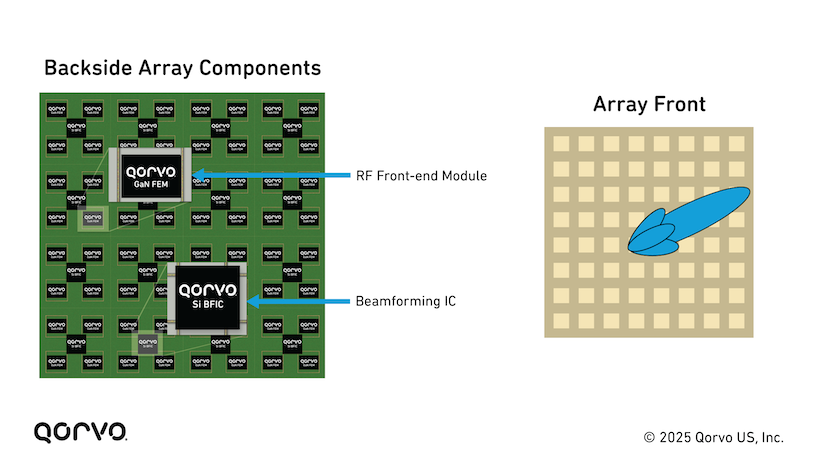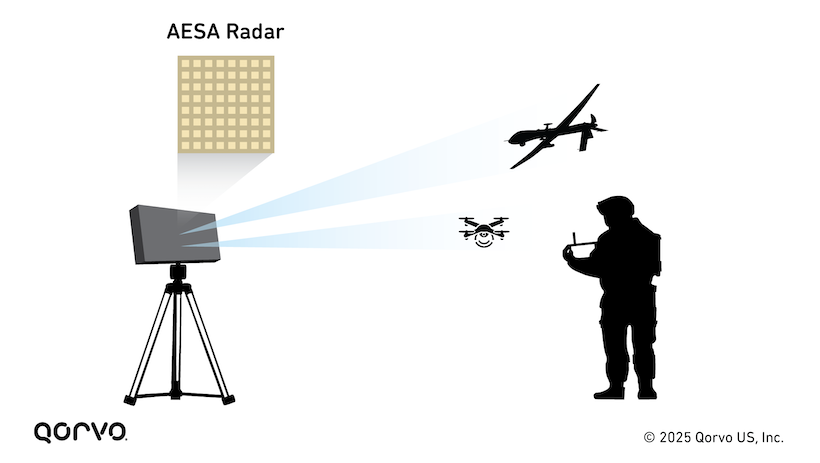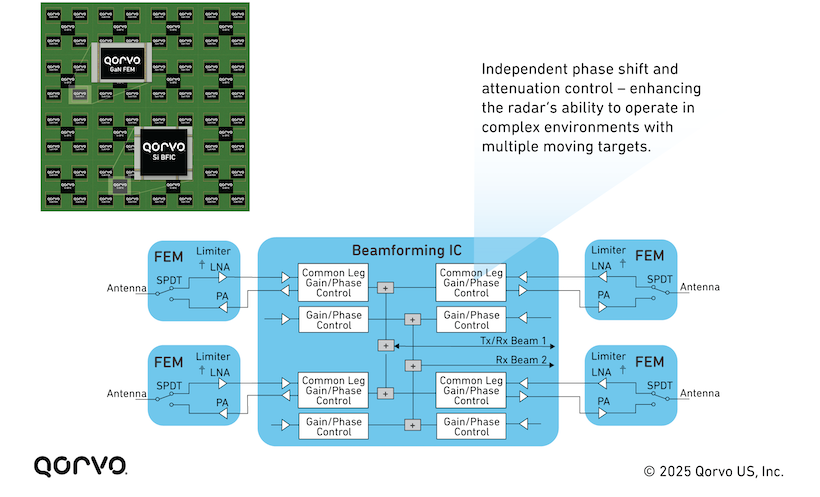X-Band Radar: Driving Defense Applications with Beamforming, GaN and GaAs Technology
February 20, 2025
The defense sector is constantly evolving to address the latest security challenges, one of which is the increasing prevalence of unmanned aerial vehicles (UAVs) or drones in critical areas. X-band radar systems, particularly those leveraging beamforming ICs (BFICs), advanced gallium nitride (GaN) and gallium arsenide (GaAs) components, are leading the way in providing the high-performance radar capabilities required for modern defense and surveillance. This article delves into the latest advancements in X-band radar technology (8-12 GHz) and discusses its applications in defense, emphasizing the contributions from Qorvo’s product innovations.

Drone Detection and Tracking: A New Security Imperative
The ability to detect, track and manage drones is becoming indispensable for defense operations. X-band radar systems are uniquely suited for this task, especially in scenarios like border security, critical infrastructure protection and mobile perimeter monitoring. These radar systems provide high-resolution detection capabilities, ensuring drones can be tracked with accuracy even in cluttered environments. The ability to differentiate drones from other small airborne objects is crucial as security demands grow around the globe. Phased array Active Electronically Scanned Array (AESA) radar systems operating at X-band offer an ideal balance of range, target resolution and size, enabling these systems to detect and monitor obstacles from significant distances. X-band radars are lightweight and self-contained, which simplifies integration into aviation systems for comprehensive aerial surveillance and threat detection.

Some advantages of using AESA radar systems include:
- Accuracy – AESAs can track multiple targets with high angular accuracy, even when the airspace is very congested.
- Reliable – AESA radar systems offer superior reliability compared to legacy radar technologies, primarily due to their lack of moving parts, which reduces mechanical wear and failure points. Additionally, they feature a "soft failure" capability, meaning that even if several array channels malfunction, the overall system performance experiences only minimal degradation.
- Fast – AESAs can transmit signal energy in microseconds, allowing the system to detect and track targets at a very high speed.
- Multi-functionality – AESA radar systems can operate in air-to-ground and air-to-air environments simultaneously.
- Environmentally stable – AESAs can see and map the ground from great distances in any weather conditions.
- Mobility – AESA radar systems are more mobile due to their sizes, lighter weight and use less power than previously used X-band radar system technologies.
- Low physical profile – AESA electronics can be realized in a planar (flat panel) antenna, allowing for low profile solutions. This AESA design approach enables planar arrays at frequencies above C-band and provides an overall smaller size, lighter weight and lower cost solution.
AESAs combined with advanced X-band BFICs are pushing the capabilities of compact radar systems in the aviation and defense markets. These systems, combined with integrated software-defined radios and beam-steering controllers, provide remote sensing coverage across a wide range of applications. Additionally, these solutions provide enhanced sensitivity and lower DC power consumption than traditional radar systems.
AESA radars also benefit significantly from X-band BFICs coupled with GaN and GaAs technologies, helping to enable long radar range, high-resolution, stable phase and amplitude control needed for rapid and precise beam steering. The combination of using these technologies – silicon for the BFIC, GaN and GaAs helps achieve SWaP-C (reduced size, weight, cost and high power). This low-profile, high-performance technology allows developers to create radar systems with optimized cascade performance, achieving lower RF power emissions, reduced false detections and increased dynamic range—attributes that open new avenues in aviation radar applications while ensuring effective, energy-efficient drone tracking and threat management.
X-Band Radar Advancements: Precision Meets Mobility
Modern X-band radar systems operate between 8–12 GHz, offering an ideal balance between range resolution, size and target detection range. Compared to lower-frequency counterparts, X-band radars use smaller antennas, allowing for the development of lightweight, self-contained radar units that are easy to deploy. This compact form factor and portability make X-band radar systems versatile and effective for remote or mobile surveillance.
One of the notable advancements in this sector is the incorporation of phased-array systems with electronic beam steering. Phased-array radars allow for rapid, precise beam control without the need for mechanical components. This technological leap is particularly beneficial in dynamic threat environments, as the radar can adapt to changing conditions in real time.
The Accuracy and Importance of BFICs in Phased Array Antennas
A core component of X-band radar performance is precise phase control for each antenna element in the phased array. High-resolution phase and amplitude control enable fast, accurate beam steering, which is essential for tracking multiple objects simultaneously. Qorvo’s beamformer ICs facilitate this capability by providing independent phase shift and attenuation control, enhancing the radar’s ability to operate in complex environments with multiple moving targets.

At the core of X-band phased array radars, beamforming ICs allow precise control over each antenna element's phase and amplitude, enabling rapid, accurate beam steering. This control is especially critical in scenarios where radar systems must distinguish between multiple, fast-moving targets in congested airspace or complex urban environments. Qorvo's X-band Beamformer IC stands out with its quad architecture featuring dual receive outputs, and it offers independent serial "SPI" control of the phase shifters and attenuators. This architecture facilitates both individual control over each channel within an IC and the daisy chaining of multiple ICs, enabling scalable radar systems that adapt to various application needs. A single positive supply further simplifies the design and reduces the overall system footprint, which is essential for low-profile deployments.
The Vital Role of Beamforming ICs, GaN and GaAs in Phased-Array Antennas
In today’s defense landscape, radar systems must meet stringent requirements for cost-effectiveness, compactness and high performance to operate effectively in complex environments. The integration of beamforming integrated circuits (ICs), along with advanced GaN and GaAs technologies, has become essential in addressing these demands, enabling radar systems to maintain accuracy, flexibility and robustness. Electronically steered active antennas, which rely heavily on these advancements, are paving the way for next-generation radar solutions optimized for critical defense applications, from UAV detection to border surveillance.
Incorporating GaN and GaAs technology into radar systems enhances performance by enabling high power output with superior thermal management. This combination is particularly advantageous in AESAs, where low-profile and lightweight designs are essential. AESA radars built with Qorvo’s X-band beamformer ICs and GaN/GaAs-based front-end modules can fit compactly within the radiating lattice of a planar antenna, making it possible to create portable yet high-performance radar units for defense applications.
The use of GaN-based technology extends beyond sheer power; it also improves efficiency. GaN's high breakdown voltage and efficiency support the design of radar systems with longer operating life and lower heat dissipation, a vital feature for defense-grade equipment that must endure extended deployments in challenging environments.
Qorvo's GaN and GaAs front-end modules (FEMs) complement the beamforming ICs by delivering high output power with exceptional thermal efficiency and low noise performance. The GaN/GaAs-based modules provide the necessary flexibility to adapt radar performance based on the specific threat environment. The low noise figure and over-drive protection of these FEMs ensure that radar systems can maintain signal integrity, even in high-density RF environments.
Low Profile, High-Performance Antennas for Modern Defense Needs
The synergy between Qorvo’s beamforming ICs and advanced GaN and GaAs modules is transforming defense radar capabilities, making high-resolution, electronically steered active antennas a viable, practical solution for today’s defense challenges. This complete X-band solution not only meets the modern requirements for performance and profile but also makes phased array technology accessible and deployable in critical surveillance and air defense applications.
For example, in AESA radar systems, each transmit/receive (TX/RX) module consists of a power amplifier (PA) along with other components. One critical requirement in AESA design is reducing overall power consumption, as these systems use numerous TX/RX modules, resulting in high energy demands. This challenge becomes more acute at higher operational frequencies, where PAs consume the majority of the system's energy. To meet these stringent power requirements, PAs in AESA systems must operate with high power-added efficiency (PAE) and gain across a broad input frequency range while still delivering sufficient output power. In this context, Qorvo has designed a highly efficient PA tailored to meet the demanding performance standards required by AESA systems, ensuring both energy efficiency and robust output.
Qorvo's silicon-based BFIC smart antenna solutions deliver optimized performance and cost-efficiency, meeting commercial and defense market demands. These products, refined over several generations, incorporate a unique architecture that enables manufacturers to build scalable arrays with effective isotropic radiated power (EIRP) ranging from 30 dBmi to greater than 70 dBmi. Key performance features include:
- Lower Energy Consumption: Dynamic array control and fast attenuator adjustments allow selective deactivation of elements and rows, shaping beams while reducing DC power—a critical feature for the energy-conscious radar industry. Using GaN high-power technology also has benefits of delivering lower power consumption.
- Ultra-Fast Beam Steering (Patented): This technology supports radar timing protocols, allowing antennas to quickly shift beam directions.
- Variable Maximum Linear Power (vMLP): This capability flexibly adapts system power to meet different operational requirements, preventing interference.
- Smart Arrays: Embedded digital cores enable real-time performance monitoring and adjustment, maintaining peak array function.
- Polarization Flexibility: The ability to generate and control various polarizations meets diverse system needs.
Qorvo's full radar array solution supports dual-polarization feeds of four antenna elements from a single IC, offering simplified integration with phased array terminals through features like low voltage supply and integrated logic control. Fabricated using silicon, GaN and GaAs technology, Qorvo’s solution perfectly balances performance and cost-effectiveness.
Qorvo's Contributions to X-Band Defense Applications
Qorvo’s X-band radar solutions offer a complete package for defense clients. These systems are optimized and pre-configured for low-cost and low-profile deployment, ensuring that radar arrays can be installed with minimal footprint and maximum operational effectiveness.
Qorvo’s integrated radar solutions support key defense applications, including:
- Border and Critical Infrastructure Surveillance: Enabling long-range, high-resolution monitoring of sensitive areas.
- UAV Detection and Air Defense: Detecting, tracking and managing UAVs and other aerial threats effectively.
- Mobile Perimeter Security: Deploying radars rapidly to secure mobile assets and temporary installations.
Additionally, Qorvo’s X-band solutions integrate advanced GaN and GaAs front-end modules (FEMs) that offer power options from 2 to 12 watts, providing users with flexibility in power output without compromising noise performance. These modules also include overdrive protection, which is essential for radar systems operating in unpredictable or high-risk environments where signal integrity is critical.
The Future is Here – X-Band Radars for Advanced Defense
The advancements in GaN and GaAs technologies are dramatically expanding the capabilities of X-band radar systems, making them indispensable for modern defense applications. GaN-based transmit/receive modules offer higher output power and improved efficiency, while GaAs contribute essential low-noise performance for precise target detection, even in congested spatial environments. Together, these materials are setting new standards for radar performance, enabling highly configurable, multi-functional systems that meet the sophisticated demands of today’s defense industry. With a modular, scalable approach, X-band radars leveraging these technologies allow defense agencies to rapidly deploy versatile solutions in various mission-critical applications.
The rapid evolution of X-band radar, powered by advancements in Beamforming ICs (BFIC), GaN and GaAs materials, is transforming defense capabilities. From drone detection to border surveillance, these compact, powerful systems are essential to the defense landscape. With companies like Qorvo advancing radar technology, the industry now has access to sophisticated, reliable tools that deliver high performance and operational flexibility, paving the way for the next generation of defense applications.
Additionally, you can find more interesting collateral on this subject by visiting our Qorvo Design Hub for a rich assortment of videos, technical articles, white papers, tools and more. For technical support, please visit Qorvo.com or reach out to Technical Support
About the Authors
Our authors bring a wealth of technical expertise in developing and optimizing radar solutions for advanced technologies. With a deep understanding of customer needs and industry trends, they collaborate closely with our design teams to drive innovation and deliver cutting-edge solutions that support industry-leading products.
Thank you to our main contributors of this article: David Corman (Chief Systems Architect), Paul Prudhomme (Senior Product Line Manager), Andy Crofts (Senior Marketing Manager) and David Schnaufer (Corporate, Technical Marketing Manager) for their contributions to this blog post, ensuring our readers stay informed with expert knowledge and industry trends.
Have another topic that you would like Qorvo experts to cover? Email your suggestions to the Qorvo Blog team and it could be featured in an upcoming post. Please include your contact information in the body of the email.